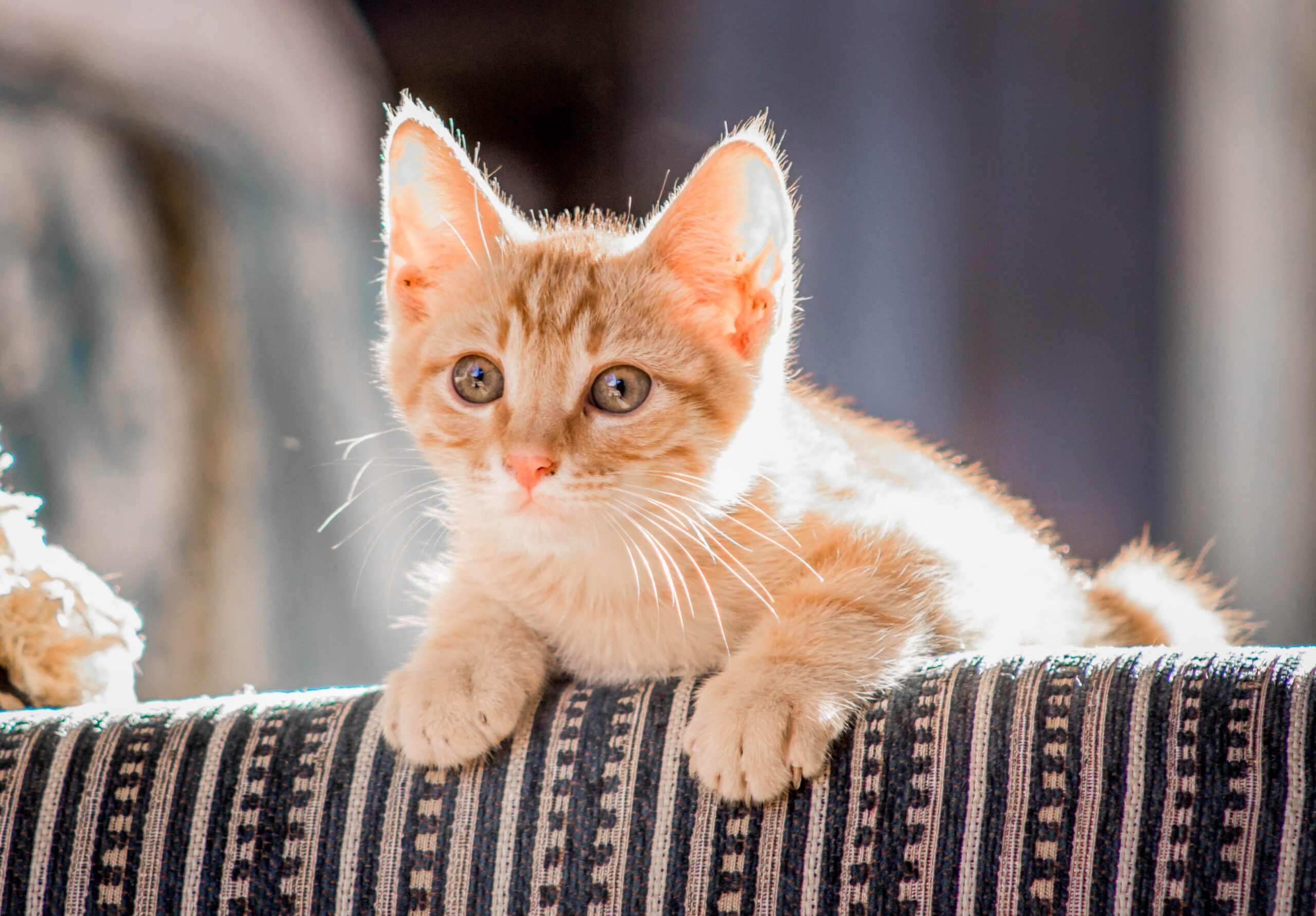![[How to] Picking the Right Cat](https://cutekittens.club/wp-content/uploads/2019/08/grey-and-white-short-fur-cat-104827.jpg)
by Margejane | Cat Health
So you’ve decided to get a kitten or cat. Congratulations! All cats and kittens are beautiful by their very nature, but it’s very important to know how to choose the right feline for YOU.
In the most ideal situation, kittens stay with their mother and littermates until they are 3-4 months old. Kittens are not born naturally sociable so it’s important that they are socialized in their early months by being lovingly handled and getting used to normal household sounds like a television, vacuum cleaners or little children.
In my experience as a foster mom for kittens, I have fostered litters where kittens have hissed at me and been extremely antisocial. Wrapping them in baby blankets and holding them close to me for extended periods of time has transformed them into sweet, affectionate babies who purr when held. This socialization process gets them ready to be ideal family pets.
When you visit a shelter or a foster’s house, observe your surroundings. It should look and smell clean. If the mother cat is available, go meet her. She has great influence on her babies, if she is sweet and loving, that’s a good indication the kittens will be, too.
When you meet the kittens, it’s a good idea to just observe them at first. Kittens who are naturally attracted to people are the best pets. Happy, socialized kittens will enjoy being handled. Kittens who get panicky and try to jump out of your hands shouldn’t be chosen. Even though that cute little kitten cowering in the corner catches your attention, skip it. I hate to say that because I believe every kitten deserves a loving home, but I feel it’s my responsibility to educate you, my valued readers, on how to choose a kitten or cat who will be sweet and loving – a joy to have in your home.
Make sure you choose a healthy kitten. They are active, have bright clear eyes, a glossy coat, and no nasal discharge. Body build should be lean without being scrawny or potbellied.
If you don’t find your dream kitten your first time out, don’t be discouraged. There are so many darling kittens out there. I highly recommend Petfinder.com. You can enter the type(s) of kittens you might like, plus the area you live in, and Petfinder will come up with photos and bios of kittens plus the names of local animal shelters and rescue groups.
If an adult cat is more to your liking, that’s also a great choice. Adult cats are easier than kittens, because basically what you see is what you get – their personalities are fully formed. One exception is an in-heat or pregnant female, because her personality may change once she’s spayed. Look for a cat who is playful and friendly. Your cat will most likely get more relaxed once they get home because noisy shelters can be stressful.
In closing, just remember – be patient, know what type of cat you want (although you may fall in love with a sweet cat who is totally different than the one you imagined bringing home) and above all, be patient. That great cat is out there for you!

by Margejane | Cat Health
Aggressiveness in cats is a natural defense mechanism that helps them stay away from others. The problem arises when the cat also attacks. His previous behavior warns us: he growls, stares at us, lifts his body, ears and tail, his fur bristles and his pupils’ contract. When this happens, it is advisable to leave the cat for a while until the cat calms down and consult with your veterinarian to determine if this behavior is physical in origin or, if not, if the cat’s aggressiveness can be helped through behavior modification or medication.
In some cases, a disease such as hypothyroidism can cause aggressiveness. Similarly, muscle and bone pain, such as arthritis, can also cause your cat to rebel when you approach pet it. Cats may display aggressive behavior if they are overstimulated, such as when being bathed or petted too much.
Help your cat feel better
In addition to following prescribed treatment, there are additional things you can do to help your cat. Follow these tips:
- Find your cat a place to be alone and quiet. A kitty condo, even a closed box lined with a soft blanket or towel with an entry cut into it can provide a safe and secure environment for your cat.
- Praising your cat’s good behavior and rewarding with treats can be encouraging.
- Play with your cat if he wants to get close – that’s a good sign! If he touches you and wants to play, get his favorite interactive toy and play.
- Get him used to interacting with other pets. On some occasions, the aggressiveness is due to your cat having trouble relating to other animals in the home. Be patient and never force the cat to interact with other animals. Time will tell if this antisocial behavior can be corrected or, as sometimes is the case, you just have a cat who prefers his solitude, in which case just accept that this is the way he is and love him as he is or, if this doesn’t work for you, consider giving him to a loving person or family where he will be the only pet.
by Margejane | Cat Health
by Margejane | Cat Health, Featured

by Margejane | Cat Health
There is no doubt that cats are the more preferred pets. In fact, the American Veterinary Medical Association revealed that more households in the United States have cats than dogs. This is not surprising as cats have some outstanding qualities that make them the absolute best. Below are eight of these qualities:
- Cats don’t take up as much space as dogs:
Regardless of the size of your dog, you would have to sacrifice a ton of space to ensure it lives a happy, healthy life. Dogs need a larger space to play and exercise, and their personal stuff will equally occupy a sizeable room in your abode.
Cats, on the other hand, do not require as much space as is needed with dogs. Aside from being generally smaller in size, their essentials such as litter boxes and water dishes won’t cost you too much space.
- Cats are less expensive to manage:
This is one of the primary reasons people choose cats over dogs. Cats are generally more affordable than dogs over the course of their lifetime. The adoption fees for cats or kittens are lower than for dogs or puppies, this is more so if it is kitten season or there is a major influx of kittens in shelters.
Due to their high activity, dogs tend to destroy their toys, hence dog toys are usually made from tougher and invariably more expensive materials. Cat toys, however, are cheaper to buy and can easily be fabricated at home.
While cats are content just lounging at home and playing with their toys, dogs require plenty of exercise for good health. On average dogs need two to three walks per day. This can be near impossible or stressful if you have a fulltime job.
- Cats are content living indoors:
While cats can spend the whole day indoors, this is almost impossible for dogs. In order for your dog to live a healthy, happy life, you must give it a lot of exercises and walks. This can be somewhat challenging for anyone with limited mobility or who don’t have access to a park or yard.
- Cats are quieter:
Regardless of how much of a dog lover you may be, you must admit the fact that incessant dog barking can be very annoying and disturbing. Dogs bark for many reasons, from seeing strangers to spotting another animal. Cats, on the other hand, are much quieter. Even at night when they tend to make their loudest noise, the meows and purrs are more cute than annoying.
- Cats are neater:
Cats are definitely neater than dogs, this is because of their self-cleaning actions. You won’t really have any reason to bathe your cat, unless if there is an emergency or some other medical reason. Dogs, on the other hand, can get that “doggy smell”. Bathing a dog can prove very challenging and dog groomers can be quite costly.
- Cats eat neatly:
Cats eat in the cutest and neatest of ways. They take small mouthfuls and tend to eat it over a long period of time. Cats will also stop eating when they are full. Dogs, however, gobble at their food. They eat as much as they can as fast as they can. They often have no limit on the quantity they will eat and can make themselves sick.
- Kittens become independent sooner:
Although kittens and puppies require a lot of time, attention, and energy, puppies tend to require more extensive and extended training than kittens, particularly as regards potty training. For kittens, by the time they are weaned from their mothers, they would have learned the basics of using the litter box. This means they can be left at home unsupervised while their owner is at work all day.
- Cats keep pests at bay:
One of the benefits of keeping cats in your home is that it ensures a pest-free home. Cats are natural born hunters and their scents alone can help to keep rodents away from your home.
In conclusion, I think we can agree that while both dogs and cats can make wonderful pets, cats are by far much easier to care for while bringing just as much joy.

by Margejane | Cat Health, Featured
FELINE URINARY TRACT DISEASES
This is a group of feline diseases with multiple causes. These can occur in unfit or overweight cats or cats who eat dry cat food. Stress and sudden changes can also raise a cat’s risk.
Symptoms include:
- Bloody urine,
- Urinating in odd places,
- Straining to urinate,
- Crying in pain when urinating and licking the urinary area due to the pain,
- Cat acting depressed,
- Dehydration,
- Loss of appetite,
- Vomiting.
URINARY TRACT PROBLEMS IN CATS
In female cats – Feline Lower Urinary Tract Disease (FLUTD) can have a number of different causes. This affects the structures that make up the lower portion of the urinary tract, which includes the bladder and urethra (the urethra is a tube that carries urine from the bladder to the outside of the body.)
Urinary tract disease can cause cats to urinate outside the litter box. Many cats end up in shelters because of this problem and end up being euthanized.
There are several potential causes of lower urinary tract disease:
- Bladder infection
- Obstruction of the urethra
- Bladder stones
- Interstitial cystitis (which is bladder inflammation) which is believed to be caused by stress.
Bladder obstructions almost always occur in males. If there is an obstruction the cat is unable to urinate. The cat will become toxic very quickly and the waste products will build up in the bloodstream. It’s crucial that you take your cat to the vet immediately if you suspect it’s not able to urinate.
Urinary tract disease symptoms are:
- Painful urination
- Loss of Appetite
- Urinating outside the litter box
- Straining to urinate (dysuria)
- Frequent attempts to urinate
- Bloody urination (hematuria)
If your cat has a urethral obstruction your vet needs to relieve the obstruction by passing a catheter through the urethra and into the bladder. Intravenous fluids may also be given as well as monitoring kidney function and blood electrolyte levels. For bladder infections, cats are given antibiotics and maybe given therapeutic diets.
You’ll need to encourage your cat to drink plenty of water. Canned food can be helpful because of their moisture content. Adding some water to it is also helpful.
Litter boxes need to be kept very clean and ideally kept in a private area where your cat won’t be disturbed. It’s also important to keep your cat’s stress level as low as possible. Keeping your cat’s favorite toys, scratching post, cat bed and available hiding places can contribute to keeping cat’s stress levels at a minimum.
In summation, encouraging water drinking, keeping your cat’s stress level low and his litter box clean can help in the prevention of urinary tract disease.
Page 6 of 7« First«...34567»
![[How to] Picking the Right Cat](https://cutekittens.club/wp-content/uploads/2019/08/grey-and-white-short-fur-cat-104827.jpg)




Recent Comments